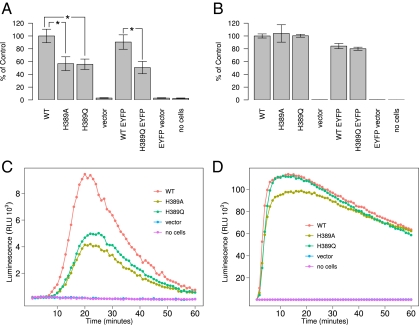Fig. 7.
NCF2 H389Q mutation leads to decreased ROS release in K562 cells. K562 cells stably transfected with CYBB and NCF1 were cotransfected with plasmids for expression of NCF4 and NCF2 WT, NCF2 H389A mutant, or NCF2 H389Q mutant with the Amaxa Nucleofector kit V, under the T-16 program. Derivatives of NCF2 tagged at the C terminus with EYFP were also tested. According to our model, a Q in position 389 binds 1.5 kcal/mol weaker than H, whereas an A binds 2.0 kcal/mol weaker than H in this position. (A) ROS production in K562 cells in response to hIgG beads in the presence of luminol and HRP (n = 4; mean ± SEM; *P < 0.05). (B) ROS production in K562 cells in response to PMA in the presence of isoluminol and HRP (n = 4; mean ± SEM; In A and B, the total relative light unit (RLU) values over 60 min, measured at 1-min intervals, are expressed as the percentage of the RLU output of NCF2 WT-transfected cells in each experiment. Data were normalized to correct for interexperiment variability and log-transformed to stabilize variance; they were tested for significance using the Student t test. Representative kinetic curves are taken from one of four independent experiments for ROS production in K562 cells in response to hIgG beads (C) or PMA (D).

